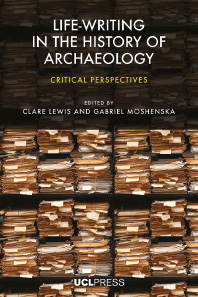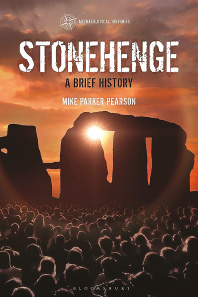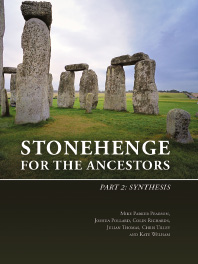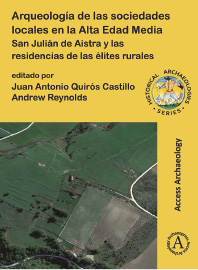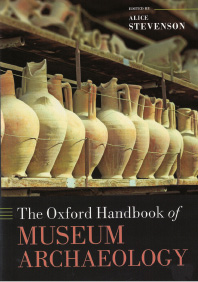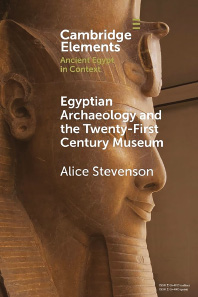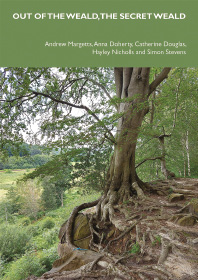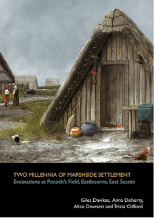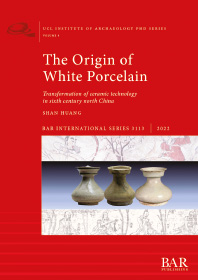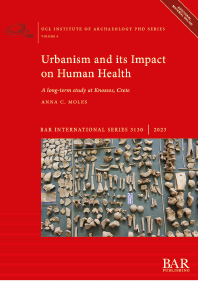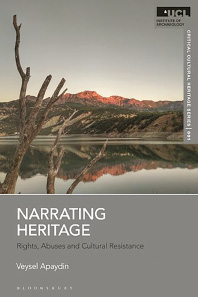Once again, the past academic year has proven a very fruitful one for Institute staff in terms of publication output. Among these, IoA archaeologist and Lecturer in the UCL Department of Arts and Sciences Clare Lewis and Associate Professor in Public Archaeology Gabriel Moshenska edited a recently published volume entitled Life-Writing in the History of Archaeology: Critical perspectives through UCL Press, which is available in open access.
Following on from last year’s publication of the first of two volumes on excavations at Cladh Hallan, the Institute’s Professor of British Later Prehistory Mike Parker Pearson published both Stonehenge: A brief history through Bloomsbury Academic, as well as Stonehenge for the Ancestors, Part 2: Synthesis alongside Joshua Pollard, Colin Richards, Julian Thomas, Chris Tilley and Kate Welham through Sidestone Press.
Andrew Reynolds, the Institute’s Professor of Medieval Archaeology, co-edited with Juan Antonio Quirós Castillo a major report on archaeological investigations of the early medieval site of San Julián de Aistra in the Álava province of the Basque Country in northern Spain. Entitled Arqueología de las Sociedades Locales en la Alta Edad Media: San Julián de Aistra y las residencias de las élites rurales, it was published by Archaeopress.
Two important books were also published by the Institute’s Associate Professor of Museum Studies Alice Stevenson. The first of these, The Oxford Handbook of Museum Archaeology, was edited by Dr Stevenson, while the second, Egyptian Archaeology and the Twenty-First Century Museum is a part of the influential Cambridge Elements in Ancient Egypt in Context series.
The Institute’s commercial archaeology wing, Archaeology South-East (ASE), has released two major site reports in the past year through their SpoilHeap imprint. Out of the Weald, The Secret Weald was authored by Andrew Margetts, Anna Doherty, Catherine Douglas, Hayley Nicholls and Simon Stevens, while Giles Dawkes, Anna Doherty, Alice Dowsett and Trista Clifford authored Two Millenia of Marshside Settlement: Excavations at Pocock’s Field, Eastbourne, East Sussex.
In terms of internal publication imprints, the Institute’s collaboration with BAR Publishing has seen two further PhD theses published: Shan Huang’s The Origin of White Porcelain: Transformation of ceramic technology in sixth century north China and Anna Moles’ Urbanism and Its Impact on Human Health: A long-term study at Knossos, Crete. Meanwhile the Institute’s new Critical Cultural Heritage Series, published through Bloomsbury Academic, saw the release of the first instalment in this series: Narrating Heritage: Rights, abuses and cultural resistance by IoA alumnus and Lecturer in Art, Design and Museology at the UCL Institute of Education, Veysel Apaydin.
Lewis, C. and Moshenska, G., eds. 2023. Life-Writing in the History of Archaeology: Critical perspectives. London: UCL Press.
In recent years life-writing has played an important role in the surge of new research in the history of archaeology, including ground-breaking studies of discipline formation, institutionalisation and social and intellectual networks. This book brings together critical perspectives on life-writing in the history of archaeology, including studies of archive formation and use, the concept of ‘dig-writing’ as a distinctive genre of archaeological creativity and reviews of new sources for already well-known lives. (Publisher’s abridged blurb)
Parker Pearson, M. 2023. Stonehenge: A brief history. London: Bloomsbury Academic.
In this book, Mike Parker Pearson draws on two decades of research, recent excavations and scientific analyses to uncover many of the secrets that this prehistoric stone circle has kept for 5,000 years. Writing for a non-specialised readership, he paints the most comprehensive picture yet of the history of Stonehenge, from its origins up to the twenty-first century.
Parker Pearson, M., Pollard, J., Richards, C., Thomas, J., Tilley, C. and Welham, K. 2022. Stonehenge for the Ancestors, Part 2: Synthesis. Leiden: Sidestone Press.
This is the second of four volumes published by Sidestone Press which present the results of the Stonehenge Riverside Project, a long-term fieldwork project to investigate the purpose of this prehistoric monument. The volume provides an overview of Stonehenge in its landscape over millennia, from before the monument was built to the last of its five constructional stages. It places Stonehenge in its full context within Britain and Western Europe during the third millennium bc.
Quirós C., Antonio, J. and Reynolds, A., eds. 2023. Arqueología de las Sociedades Locales en la Alta Edad Media: San Julián de Aistra y las residencias de las élites rurales. Oxford: Archaeopress.
This multi-author volume brings together a large number of specialised studies and provides an interpretation of the site of San Julián de Aistra (Zalduondo-Araia, Álava) in terms of the socio-political practices that define the main characteristics of early medieval local societies in the north-west of the Iberian Peninsula. Extensive excavations led by a UCL Institute of Archaeology team in collaboration with archaeologists from the University of the Basque Country revealed a long sequence of occupation from prehistory and the Roman period, but more particularly a detailed picture of rural settlement across the early medieval period up to the fourteenth century.
Stevenson, A., ed. 2022. The Oxford Handbook of Museum Archaeology. Oxford: Oxford University Press.
This Handbook provides a transnational reference point for critical engagements with the legacies of, and futures for, global archaeological collections. It challenges the misconception of museum archaeology as simply a set of procedures for managing and exhibiting assemblages, instead advancing reflexive research and practice to address critical issues of what gets prioritised by and researched in museums, by whom, how and why. Throughout, the authors problematise and suggest new ways of thinking about historic, contemporary and future relationships between archaeological fieldwork and museums, to situate museum work within a more holistic archaeology that does not privilege excavation or field survey above other aspects of disciplinary engagement. (Publisher’s abridged blurb)
Stevenson, A. 2022. Egyptian Archaeology and the Twenty-First Century Museum. Cambridge: Cambridge University Press.
This book addresses the cultural production of ancient Egypt in the museum as a mixture of multiple pasts and presents that cohere around collections – their artefacts, documentation, storage, research and display. Its four sections examine how ideas about the past are formed by museum assemblages: how their histories of acquisition and documentation shape interpretation, the range of materials that comprise them, the influence of their geographical framing and the moments of remaking that might be possible. Throughout, the importance of critical approaches to interpretation is underscored, reasserting the museum as a site of active research and experiment, rather than only exhibition product or communicative media. (Publisher’s abridged blurb)
Archaeology South-East/SpoilHeap Publications
Margetts, A., Doherty, A., Douglas, C., Nicholls, H. and Steven, S. 2023. Out of the Weald, The Secret Weald. Portslade: ASE/SpoilHeap Publications.
This volume details the results of archaeological work conducted by Archaeology South-East (UCL Institute of Archaeology) across four sites within the Sussex Weald. Among the findings presented here are some regionally important remains, including one of just a handful of known Palaeolithic finds with a Wealden provenance, perhaps some of the earliest land division so far excavated in the Wealden region, a Roman shrine and what could possibly constitute the remains of an Iron Age fort, one of the hill-slope type. (Publisher’s blurb)
Dawkes, G., Doherty, A., Dowsett, A. and Clifford, T. 2023. Two Millenia of Marshside Settlement: Excavations at Pocock’s Field, Eastbourne, East Sussex. Portslade: ASE/SpoilHeap Publications.
This excavation, at the juncture of the South Downs and Willingdon Levels in Eastbourne, East Sussex, revealed archaeological evidence that this location was home to communities that exploited and interacted with these two different landscapes from the early prehistoric to the post-medieval period. Key settlement phases include: large-scale salt-working in the Early/Middle Iron Age, Roman occupation with a specialist crop-processing function, Early Anglo-Saxon sunken-featured buildings and a post-built hall and a mid-fifteenth-century substantial masonry farmhouse.
BAR UCL Institute of Archaeology PhD Series
In 2019 the Institute launched a new series with BAR Publishing to publish PhD theses. This substantial series promotes the Institute’s outstanding postgraduate research programme across the theory and practice of archaeology, conservation and heritage. In 2022 BAR Publishing won the prestigious IPG Academic and Professional Publisher of the Year award. A full list of all titles published in the BAR UCL Institute of Archaeology PhD Series can be found on the Institute’s website.1
Two titles have been published since Archaeology International 25(1).
Shan, H. 2022. The Origin of White Porcelain: Transformation of ceramic technology in sixth century north China. UCL Institute of Archaeology PhD Series 8. Oxford: BAR Publishing.
Ceramic technology in the sixth century was transformed from a pattern of earthenware and stoneware production to porcelain and polychrome decoration through a process until now unclear. This volume focuses on the typo-chronology of three major categories of glazed ceramics recognised with in-situ pXRF analysis of items discovered from sixth-century burials in north China. It provides insights into changing technologies and the social dynamics that drove them and discusses their enduring impact.
Moles, A. C. 2023. Urbanism and Its Impact on Human Health: A long-term study at Knossos, Crete. UCL Institute of Archaeology PhD Series 9. Oxford: BAR Publishing.
This volume demonstrates how social, economic and political changes affected the health and diet of the people of Knossos during the Hellenistic, Roman and Late Antique periods. Knossos, an important site in Aegean and Mediterranean networks, has been extensively studied and documented, allowing a contextualised interpretation of the social history of its people over time through the integration of the present osteological and isotopic research with previous work on material culture and textual sources.
The World Archaeology Series and the Critical Cultural Heritage Series
The Institute of Archaeology also produces two series in partnership with Bloomsbury Academic: the World Archaeology Series, General Editor Ruth Whitehouse; and the Critical Cultural Heritage Series, General Editor Beverley Butler.
The first of these, the World Archaeology Series, promotes a programme that includes theory, research, pedagogy, reference material and good practice of the highest quality across archaeology, cultural heritage and cognate disciplines, including ethnographic work and conference proceedings. The second, the Critical Cultural Heritage Series, specifically asks new questions about what heritage is and does and why it is important. It seeks out as-yet-unconceptualised notions of heritage that traverse disciplinary boundaries and draws on perspectives from a similarly wide range of material.
Both series welcome submissions for authored and edited volumes from scholars and practitioners worldwide. One title in the Critical Cultural Heritage Series has been published since the previous issue of Archaeology International, with another two manuscripts in progress. In the World Archaeology Series, one title is about to enter production with publication expected in early 2024; this will be the second volume in this series.
The Institute has been publishing prestigious books since 1977. In that time, over 90 titles have been published by, successively, the Institute of Archaeology, UCL Press, Left Coast Press and Routledge, part of the Taylor & Francis group. A full list of these older titles, now distributed by Routledge, can be found in the Institute’s website.2
Apaydin, V. 2023. Narrating Heritage: Rights, abuses and cultural resistance. Critical Cultural Heritage Series 001. London: Bloomsbury Academic.
This book uses original ethnographic research and unique case studies to examine different approaches to heritage, demonstrating its importance in securing human rights and social justice. Drawing on over 10 years of research and ethnographic fieldwork, this multi-layered work compares six case studies from Turkey with others from elsewhere; its analysis includes an examination of the relationship between violence and human rights as well as the impact of authoritarianism and neoliberal policies on heritage-making.


